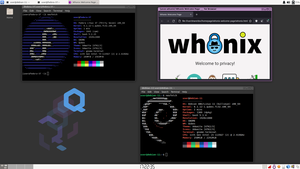Qubes OS
 | |
 | |
| Developer | The Qubes OS Project |
|---|---|
| OS family | Linux (Unix-like) |
| Working state | Current |
| Source model | Open source with proprietary blobs,[1][2] |
| Initial release | September 3, 2012[3] |
| Latest preview | 4.2.0-rc5[4] / November 26, 2023 |
| Available in | Multilingual |
| Update method | DNF (PackageKit) |
| Package manager | RPM Package Manager |
| Platforms | x86-64 |
| Kernel type | Microkernel (Xen Hypervisor running minimal Linux-based OSes and others) |
| Userland | GNU |
| Default user interface | Xfce |
| License | Free software licenses (mainly GPL v2[5]) |
| Official website | qubes-os |
Qubes OS is a security-focused desktop operating system that aims to provide security through isolation.[6] Isolation is provided through the use of virtualization technology. This allows the segmentation of applications into secure virtual machines called qubes. Virtualization services in Qubes OS are provided by the Xen hypervisor.
The runtimes of individual qubes are generally based on a unique system of underlying operating system templates. Templates provide a single, immutable root file system which can be shared by multiple qubes.
This approach has a two major benefits. First, updates to a given template are automatically "inherited" by all qubes based on it. Second, shared templates can dramatically reduce storage requirements compared to separate VMs with a full operating install per secure domain.
The base installation of Qubes OS provides a number of officially supported templates based on the Fedora and Debian Linux distributions. Alternative community-supported templates include Whonix, Ubuntu, Arch Linux, CentOS, or Gentoo.[7] Users may also create their own templates.
Operating Systems like Qubes OS are referred to in academia as Converged Multi-Level Secure (MLS) Systems.[8] Other proposals of similar systems have surfaced[9][10] and SecureView and VMware vSphere are commercial competitors.[citation needed]
Installation
매체 얻기
홈페이지 다운로드 지면에서 정보를 얻을 수 있습니다. 직접 다운로드가 느리게 동작하면, 토렌트를 이용할 수 있습니다. 여기서는 R4.2.0을 사용합니다.
QEMU/KVM
데비안 12 기반으로 만듭니다.
- Memory : 4G
- CPU : 4
- HDD : 30G
그래픽이 깨져서 설치를 진행할 수 없습니다.
VirtualBox
Red Hat (64-bit)로 자동 검색됩니다. 자동 설치를 하지 않고, 크기는 이전과 마찬가지로 진행합니다.
- Welcome : English
- Unsupported hardware detect 메시지 출력 (가상 환경이라서 나오는 메시지입니다)
- 설치 진행은 페도라와 동일합니다:
- 기본적으로 하드디스크 암호화를 진행하니, 디스크 설정에서 제거하는 것이 좋습니다.
- 마우스 인터럽트를 허용하지 않아서 설치 중에 호스트로 마우스를 가져올 수 없습니다.
Configurations
재시작 후에 설정 과정이 있지만, Next 버튼이 보이지 않습니다.
게다가 로그인 후에도 마우스를 호스트로 가져올 수 없습니다.
일반적인 데스크탑 용도로 사용하는 것이 어려울 수 있습니다.
References
- ^ "Will Qubes seek to get certified under the GNU Free System Distribution Guidelines (GNU FSDG)?".
- ^ "Qubes OS License".
- ^ "Introducing Qubes 1.0!". September 3, 2012.
- ^ "Qubes OS 4.2.0-rc5 is available for testing". www.qubes-os.org. 2023-11-26. Retrieved 2023-11-30.
- ^ "License Qubes OS". www.qubes-os.org.
- ^ "Qubes OS bakes in virty system-level security". The Register. September 5, 2012.
- ^ "Qubes OS Templates".
- ^ Issa, Abdullah; Murray, Toby; Ernst, Gidon (2018-12-04). "In search of perfect users: towards understanding the usability of converged multi-level secure user interfaces". Proceedings of the 30th Australian Conference on Computer-Human Interaction. OzCHI '18: 30th Australian Computer-Human Interaction Conference. Melbourne Australia: Association for Computing Machinery (ACM). p. 572576. doi:10.1145/3292147.3292231. ISBN 978-1-4503-6188-0. Retrieved 2020-11-01.
- ^ Beaumont, Mark; McCarthy, Jim; Murray, Toby (2016-12-05). "The cross domain desktop compositor: using hardware-based video compositing for a multi-level secure user interface". Proceedings of the 32nd Annual Conference on Computer Security Applications. ACSAC '16: 2016 Annual Computer Security Applications Conference. Los Angeles California USA: Association for Computing Machinery (ACM). p. 533545. doi:10.1145/2991079.2991087. ISBN 978-1-4503-4771-6. Retrieved 2020-11-01.
- ^ Atanas Filyanov; Nas, Aysegül; Volkamer, Melanie (July 1, 2013). "Poster: On the Usability of Secure GUIs". p. 11. S2CID 17605611.
{{cite web}}: Missing or empty|url=(help)
